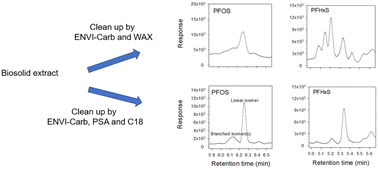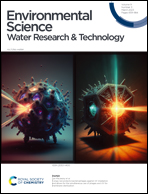The analysis of per- and polyfluoroalkyl substances in wastewater sludges and biosolids: which adsorbents should be used for the cleanup of extracts?†
Abstract
The analysis of PFAS in wastewater treatment sludges and biosolids is an evolving practice for which a widely recognized standard method does not currently exist. While a number of analytical techniques have been reported in the literature, individual methods were found to not be broadly applicable over a range of sludge/biosolid matrices. This study critically examined the method employed to clean up biosolid extracts prior to LC-MS/MS analysis, which was determined to be crucial to obtaining acceptable chromatogram quality and recoveries of a range of PFAS and associated surrogates. When ENVI-Carb was employed alone or in combination with WAX, as described in US EPA Draft Method 1633, precipitates were formed when methanolic extracts were reconstituted with water, preventing direct analysis by LC-MS/MS. Centrifugation and filtration of reconstituted extracts to remove precipitates did not sufficiently eliminate interferences to allow PFAS quantification. The use of blends of adsorbents (ENVI-Carb, PSA, C18) with different adsorptive properties that could remove a broader range of interfering substances was evaluated. A blend consisting of 1000 mg ENVI-Carb, 500 mg PSA and 500 mg C18 was found to effectively eliminate background interference while providing an optimal trade-off between chromatogram quality and PFAS recovery. When integrated into the overall analytical method, the recoveries of PFAS were between 40% and 160% except for some precursors when six different biosolids were analyzed. The cleanup method developed in this study has the potential to facilitate the analysis of PFAS in a broad range of sludge and biosolid matrices.



 Please wait while we load your content...
Please wait while we load your content...